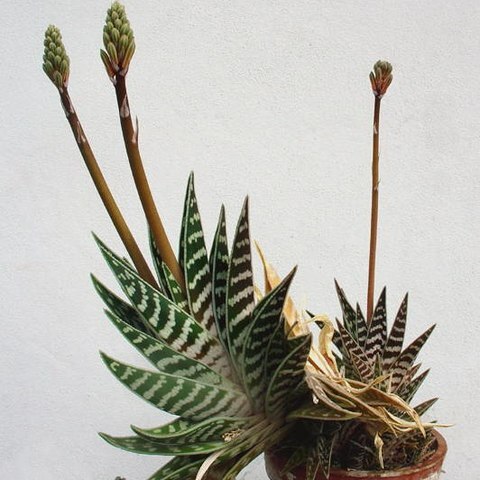Succulent, perennial herb. Plants acaulescent; stoloniferous, forming dense groups. Leaves Gasteria-like; blade narrowly ovate-deltoid, 100-150 mm long; margins white, horny, with closely spaced, small protuberances; keeled, without spines or prickles, distinctly 3-ranked, green or brownish, mottled white. Flowers: inflorescence usually branched, ± 0.3 m high, with conical, lax racemes; stamens not or very shortly exserted, stigma exserted; perianth nodding, 35-45 mm long, dull pink to red, rarely yellow; Jul.-Sep.
Succulent, perennial herb; acaulescent, stoloniferous, rosettes erect, suckering to form dense groups. Leaves green or brownish, mottled white, lanceolate-deltoid, keeled, 100-150 mm long, without spines or prickles, distinctly 3-ranked, margins white, horny, with closely spaced, small teeth. Inflorescence usually branched, ± 0.3 m high, with conical, lax racemes. Flowers dull pink to red, rarely yellow, nodding, 35-45 mm long; stamens not or very shortly exserted; stigma exserted. Flowering time July-Sept.
Acaulescent, succulent perennial, suckering to form dense groups. Leaves green or brownish, mottled white, lanceolate-deltoid, keeled, 10-15 cm long, without spines or prickles, 3-ranked; margins white, horny, with closely spaced, small teeth. Racemes conical, lax, usually branched, ± 30 cm high. Flowers dull pink to red, rarely yellow, 35-45 mm long; stamens not or very shortly exserted, stigma exserted.
Acaulescent, 100-300 mm tall. Leaves green or brownish, mottled white, keeled, without spines or prickles, distinctly 3-ranked, margins white, horny, with closely spaced small teeth. Flowers in usually branched, conical racemes, relatively large, nodding, dull pink to red, rarely yellow.

